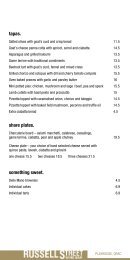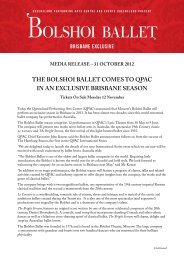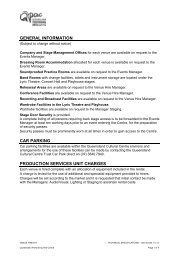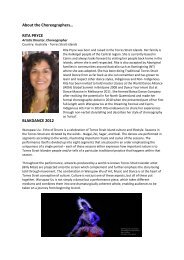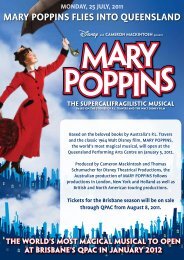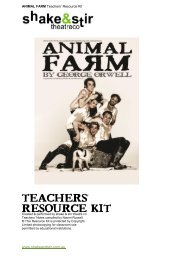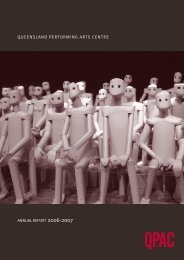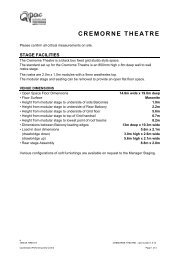Annual Report - QPAC
Annual Report - QPAC
Annual Report - QPAC
Create successful ePaper yourself
Turn your PDF publications into a flip-book with our unique Google optimized e-Paper software.
QUEENSLAND PERFORMING ARTS TRUST<br />
(d) Depreciation and amortisation of property, plant and equipment (continued)<br />
Capital work-in-progress is not depreciated until it reaches service delivery capacity.<br />
Where assets have separately identifiable components, these components are assigned useful lives distinct<br />
from the asset to which they relate. Any expenditure that increases the originally assessed capacity or service<br />
potential of an asset is capitalised and the new depreciable amount is depreciated over the remaining useful<br />
life.<br />
The depreciable amount of improvements to or on leasehold land is allocated progressively over the estimated<br />
useful lives of the improvements to the Trust or the unexpired period of the lease, whichever is shorter.<br />
Major depreciation rates used are listed below and are consistent with the prior year unless otherwise stated:<br />
Buildings and leasehold improvements 4 to 20%<br />
Motor vehicles 20%<br />
Plant and equipment 1 to 33%<br />
Concert Hall Grand Organ 2%<br />
(e)<br />
Intangibles<br />
All intangible assets with a cost or other value greater than $100,000 are recognised in the financial statements,<br />
with items of a lesser value being expensed. Each intangible asset is amortised on a straight line basis over its<br />
estimated useful life to the Trust, less any anticipated residual value. Current amortisation rates are either 20%<br />
or 33.3%.<br />
(f)<br />
Impairment of Non-Current Assets<br />
All non-current physical and intangible assets are assessed for indicators of impairment on an annual basis.<br />
If an indicator of possible impairment exists the assets recoverable amount is determined. The recoverable<br />
amount is determined as the higher of the asset’s fair value (net of selling costs) and the depreciated<br />
replacement cost.<br />
An impairment loss is immediately recognised in the income statement. If the asset in question is carried at a<br />
revalued amount then any impairment loss is first offset against the asset revaluation reserve of the relevant<br />
asset class to the extent available.<br />
If an impairment loss subsequently reverses, the carrying amount of the asset is increased to the revised<br />
estimate of its recoverable amount, but only to the extent that the carrying amount does not exceed the carrying<br />
amount that would have been determined had no previous impairment loss been recognised for the asset. A<br />
reversal of an impairment loss is recognised as income, unless the asset is carried at a revalued amount, in<br />
which case the reversal of the impairment loss is treated as a revaluation increase.<br />
(g)<br />
Cash and Cash Equivalents<br />
For the purposes of the Balance Sheet and the Cash Flow Statement, cash assets include all cash and cheques<br />
receipted but not banked at 30 June as well as deposits at call with financial institutions. It also includes liquid<br />
investments with short periods to maturity that are convertible readily to cash on hand, at the investor’s option<br />
and that are subject to a low risk of changes in value.<br />
(h)<br />
Receivables<br />
Trade debtors are recognised at the nominal amounts due at the time of sale or service delivery, with settlement<br />
being generally required within 30 days from the invoice date.<br />
The collectability of receivables is assessed periodically with provision being made for doubtful debts.<br />
Bad debts are written off in the period in which they are recognised.<br />
(i)<br />
Inventories<br />
Inventories are valued at the lower of cost or net realisable value and are comprised of trading stock for the<br />
Trust’s gift shop and stock for the Trust’s catering operations.<br />
(j)<br />
Other Financial Assets<br />
Investments are measured at cost.<br />
Interest is recognised on an accrual basis.<br />
Notes to the Financial <strong>Report</strong> for the year ended 30 June 2009<br />
48



